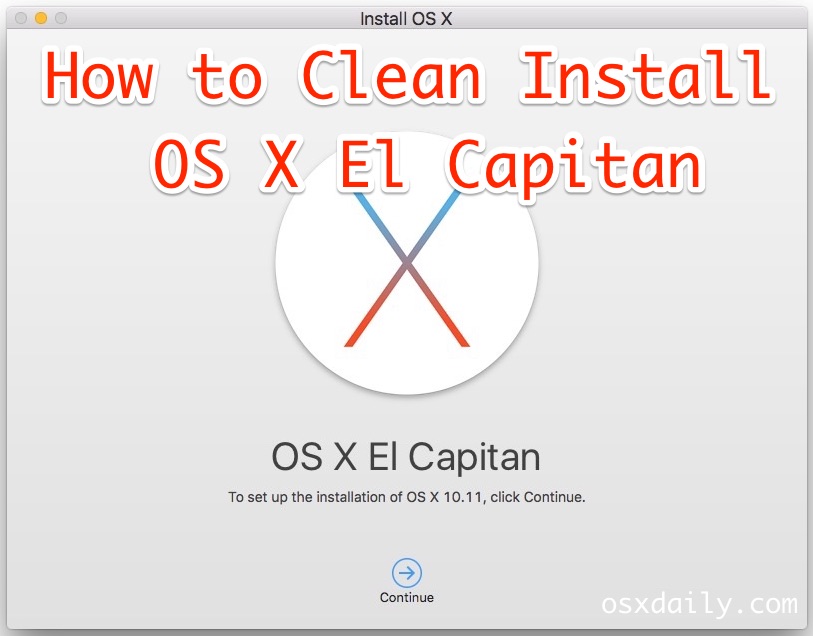- Install OS X El Capitan 10.11.6.iso (7.14 GB) Choose free or premium download.
- Nstall OS X 10.11.4 (or later). I would first check to to see if your Mac is compatible to upgrade the the latest version of MacOS. One thing to note about MacOS Catalina is that it drops support for 32-bit applications. If you still use 32 bit applications you could upgrade to MacOS Mojave, 10.14 if your Mac supports it.
On this page:
Just before you install the new Mac OS X El Capitan, you must perform few tasks to ensure that your Mac will be ready for the installation of the software: Check Your Mac - Check whether your Mac will be able to run the new OS X 10.11. Apple's latest update to Mac OS X, 10.11 El Capitan, is currently available in the Mac App Store for everyone to download and install at no cost. The new OS features Split View mode for better multitasking, a cleaner Mission Control, smarter Spotlight, a way to mute Safari tabs playing audio, enhanced Mail and Notes apps, and more. Check if your device is compatible with OS X EI Capitan update and install OS X 10.11.6/10.11.4 to your MacBook/iMac.
- Reinstalling Yosemite on a computer alreadyrunning it
Upgrading from previous versions to OS X 10.10 (Yosemite)
OS X 10.10 (Yosemite) is no longer available for purchase from theMac App Store. If you have a previous version of the operating system,and your computer meets the system requirementsfor OS X 10.11 (El Capitan), you can upgrade directly to thatversion instead; see ARCHIVED: Install or upgrade OS X 10.11 (El Capitan)
Reinstalling Yosemite on a computer already running it
Reinstalling while keeping files, applications, and settings
- Restart your computer, and immediately hold down
command-runtil the gray Apple logo appears. - If prompted, select your main language and then click the arrow.
- Click Reinstall OS X, and then Continue. Follow the instructions on the screen, and then choose your hard disk. Click Install, and enter your Apple ID information if prompted.
- When the installation is complete, select App Store... from the Apple menu, and install any available updates.
Reinstalling while erasing everything on your computer
Restart your computer, and immediately hold down
command-runtil the gray Apple logo appears.- If you see a screen asking you to select your main language,choose it, and then click the arrow.
- Click Disk Utility, and then Continue.
- In Disk Utility:
- Click your hard disk in the left column, and thenclick the Erase tab.
- Next to 'Format:', make sure Mac OS Extended (Journaled)is selected. In the 'Name:' field, give your disk a name.
- If you would like to securely erase your data, click SecurityOptions..., adjust the slider accordingly, and clickOK.
- When you're ready, click Erase..., and thenErase again to erase your disk.
- Once it's completed, quit Disk Utility.
- Click Reinstall OS X, and then Continue:
- Follow the instructions on the screen, and then choose your harddisk.
- Click Install. If prompted, enter your Apple IDinformation.
- Once the installation is complete, you'll beasked to enter basic information, and have the option to transfer datafrom another computer or backup.
- From the Apple menu, select App Store, and then installany available updates.
How to Install System Software on:
El Capitan OS X 10.11
Sierra OS X 10.12
Also works on…
High Sierra OS X 10.13
Mojave OS X 10.14
Install 10.11.4 On Mac
But, Catalina OS X 10.15 is rather hit and miss
and BigSur OS X 11 seems no go at all.
El Capitan os x 10.11 for Mac is like Win10 for Windows – Neither are LightScribe friendly.
It’s the fact that the problem stems from the fact that HP stopped developing the software back in March 2013 – nearly 3 years now long before El Capitan was released! They (the wise guys at Mac HQ) have done something different this time, as Yosemite OS X 10.10 was fine…

However, folks much smarter than I am have found the cause of the problem and have sent me the solution…
My thanks go to, Stefan Ilchenko and Jo Vandeweghe – Thanks guys… 🙂
However please understand I am not a Mac expert so I offer this to you to try but can’t offer any direct support on its implementation…
.
The Problem With El Capitan OS X 10.11 and Sierra OS X 10.12
.
The cause is the SIP (system integrity protection) enabled.
The Solution…
.
To disable follow these steps:
- Boot to Recovery OS by restarting your machine and holding down the Command and R keys at startup.
- Launch Terminal from the Utilities menu.
Mac Os 10.11 Install
- Enter the following command: csrutil disable
- Reboot your computer.
- Download newest Lightscribe Host software; expand the .tar file on the desktop
- Install Pacifist 3.5.7 version and install the lightscribe.pkg file with Pacifist.

- Then you can, with the terminal command “csrutil enable”, as action describe above, enable the SIP again.
Install 10.11.4
Et voilà, the LACIE lightscribe software and Disc Cover 3, come back to recognize the Lightscribe drive.
I hope this works for you as it has for many other long-suffering El Capitan and Sierra users…
Os X 10.11 Install
Steve
.
Please share this article if you have found it useful.
Install Os X 10.11
Let’s help as many LightScribe users to keep on Scribing… 🙂
.